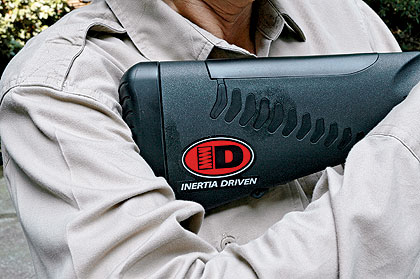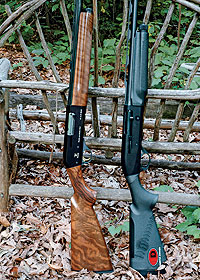By Layne Simpson
Either the force of recoil or the flow of propellant gas operates the actions of most semiautomatic shotguns built today. Both types have advantages and disadvantages.
 The dozen chevrons located in the sidewalls of the buttstock along with the recoil pad and comb insert are made of a shock-absorbing material originally developed for use in the medical industry. |
When a gun is operated by gas it has the ability to prolong recoil delivery to the shooter and this makes its kick feel lighter than it actually is. Actual recoil remains the same regardless of design but as perceived by the shooter it is lighter with the gas gun.
Then we have the matter of reliability. Due to its more simple design, a good recoil-operated shotgun will usually require less frequent cleaning than a gas-operated gun. This is why South American outfitters who offer high-volume dove shooting often recommend it. When both types of autoloaders are cleaned as needed, they are equally reliable but the recoil gun can usually be expected to go longer without cleaning. This assumes the two guns being compared are of equal quality.
But as it goes with many things in life, we must sometimes sacrifice one thing in order to gain something else. As a rule, the typical recoil-operated gun is less comfortable to shoot because it lacks the ability to widen the recoil curve the way a gas gun does. One only has to shoot a Browning Auto-5 alongside a Remington Model 1100 to realize just how true this is.
There is one other thing as well; in most cases the absence of gas-handling parts makes the recoil-operated gun lighter and as gun weight decreases recoil increases, all else being equal. One way to get around this is to stick with the lightest practical loads that will get the job done.
 Soft dimples (called Air-Touch) at the wrist and forearm of the stock isolate the hands from recoil and offer a non-slip grip. |
One of my favorite ruffed grouse guns is a 51„2-pound Franchi 48AL in 20 gauge. I can carry that handsome little thing all day long in one hand while pushing brush with the other and then when a fleeting shot does come it will get on the bird just a tad quicker than lightning.
A recoil-operated gun would kick me into the next county if I fed it extremely heavy loads, but shots in the grouse woods are usually so close nothing more potent than the lightest 7„8-ounce loads available are needed.
Recoil-Absorbing ComforTech
Leave it to the guys at Benelli to come up with a way to make their Inertia-Driven shotguns kick like gas guns. They accomplished this by creating a stock that absorbs a big chunk of the pain before it reaches the shooter.
Called ComforTech, the stock is made of a lightweight synthetic material and it wears an extremely thick recoil pad made of a super shock-absorbing, rubber-like material developed for the medical industry. The pad is ergonomically shaped to rest comfortably inside the shoulder pocket of the shooter and its surface is grooved to prevent slippage.
 My Franchi 48AL at left is more handsome but the ComforTech stock of the Benelli Cordoba at right makes it far more tolerable to shoot with heavy 20-gauge loads. |
Dimpled areas formed into the stock at its wrist and forearm (called Air-Touch) serve to partially isolate the hands from shock. They also offer positive grasping surfaces that are not at all abrasive to the hands during recoil.
Mention recoil and some shotgunners immediately think of an external force quickly applied to the shoulder when as much if not more discomfort is applied by the comb of the stock to the face--which just happens to be one of the most sensitive parts of the human body. But again, those clever engineers at Benelli have eased the pain there by installing a shock-absorbing strip along the top of the comb.
It is made of the same material as the recoil pad and in addition, a total of 22 slots cut completely through the sidewalls of the stock are also filled with it. Making the wall of the stock thin to begin with and then cutting the slots into its sides allows it to flex during recoil and the 22 rubber chevrons soak up part of the push before it reaches the shooter.
What this all adds up to is the entire buttstock, and not just a recoil pad, serves as a recoil-reducer. Special test fixtures developed at Benelli revealed that when the same 12-gauge loads were fired in two Super Eagle guns--one with a ComforTech stock, the other with a standard stock--the former reduced peak recoil by as much as 40 percent.
 The hull is being ejected and the shell has moved from magazine to bottom of receiver in preparation for its trip to the chamber. |
Energy delivered to the shoulder of a shooter is reduced over the entire recoil curve, and not just during its peak.
For a time the new stock was available only on 12-gauge guns but you can now get it on the Cordoba and M2 Field in 20-gauge. The M2 Field weighs an ounce over six pounds on my postal scale, darned light for an autoloader. Combine the latest in recoil-reduction technology with the relatively light recoil of the 20-gauge shotshell, all wrapped up in a lightweight gun and you have a combination that's as easy on the shoulder as it is fun to carry in the field.
The ComforTech stock is not as pleasing to the eye as a nice piece of walnut and for that reason I would not want one on my Franchi 48AL. But when it comes to making the use of heavy loads in a lightweight gun tolerable, it is not a bad way to go.






